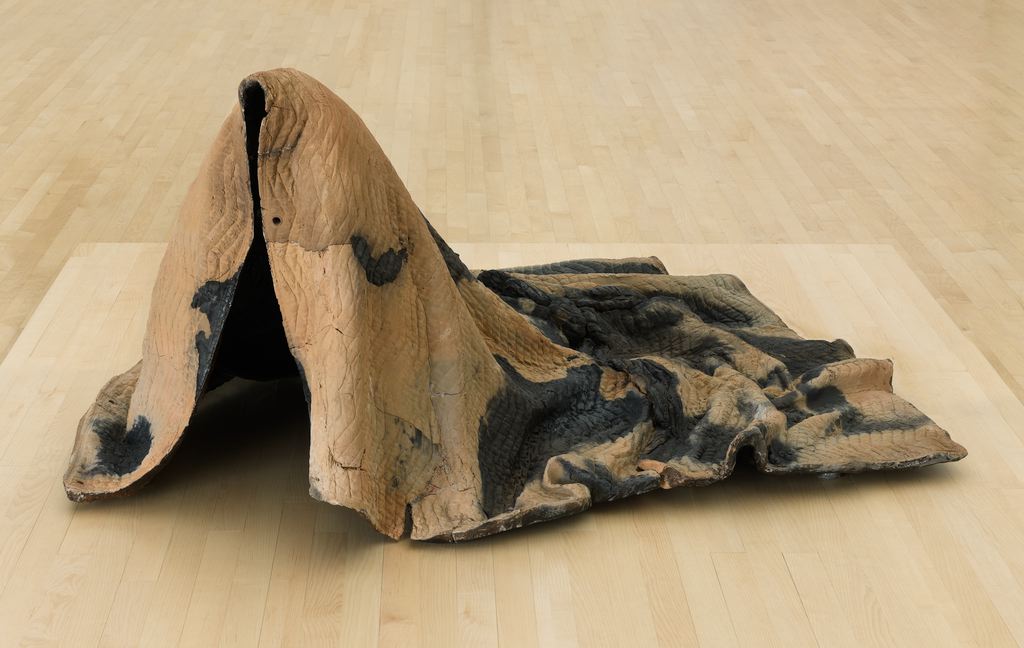
Rebecca Belmore’s Tarpaulin No. 1 (2018) responds to the crisis of homelessness in the city of Vancouver, Canada. In a short text about this work, the artist describes a specific encounter with a man living on the streets of her neighborhood:
One day when I was putting our empties out for someone to find, I ran into a brother, an Indigenous man with his shopping cart half empty. I gave him a full garbage bag, and, with a big smile, he offered me a smoke. I declined. Before I turned to leave, he asked me if I wanted an “Indian blanket.” I accepted his humble gift, a small, plaid-patterned fleece blanket like the ones you can buy at Walmart.[1]
Tarpaulin No. 1 resembles the blanket in this story, and the suggestion of a figure underneath it summons the specter of dispossession. In Canada, homelessness disproportionately affects Indigenous people. Belmore, an Anishinaabe artist, often addresses Indigenous struggles in her work. The sculpture becomes an assertion of Indigenous presence and a reproof of the colonial history that created the conditions for this neglect—an attempt, in her own words, to render “the invisible visible.”[2] Now part of SFMOMA’s permanent collection, Belmore’s sculpture provokes reflection on the housing inequality that plagues our own city, San Francisco, and the way we so often choose not to see the devastation right in front of us.
The sculpture takes its name from the tarps often erected along sidewalks for shelter, but it also conjures the term’s etymology: “tar” comes from the coal or wood pitch once used to weatherproof canvas, and “pall” refers to a cloth spread over a coffin or tomb. The ghostly emptiness of Tarpaulin No. 1 evokes the latter, while the black smudges that stain the blanket summon the former. It is as if this figure has been “tarred” or publicly humiliated. The blotted patina also recalls the smallpox blankets given to Indigenous Peoples during the colonial era, drawing modern homelessness into a longer arc of racial injustice.

The absence of a figure underneath this blanket reenacts the way we look at, but do not see, those who are unhoused. As viewers, our curiosity compels us to peer under the raised cover, but the sculpture frustrates the urge to witness and makes us question the selective nature of our gaze: while many choose to ignore someone covered in a blanket on a city sidewalk, as an artwork the same scene draws our close attention. Belmore’s sculpture assumes the form of an ethical phantom—the haunting apparition of our double standards.
By casting and firing the blanket in clay, however, Belmore infuses the work with empowerment. In her 1991 performance Creation or Death: We Will Win, the artist pushed a pile of sand up a staircase with her arms and legs bound, alluding to the struggle of Indigenous people to reclaim territory. Like the sand in this earlier work, the clay in Tarpaulin No. 1 symbolizes territory itself, its loamy brown folds rising up from the ground like rugged topography—as if to restore land to the landless. To create the sculpture, Belmore used all of what she once called “the essential elements”: earth and water, hardened with air and fire.[3] Binding these forces to people who are unhoused recognizes their mettle in the face of harsh weather. Belmore’s sculpture begins to resemble a carapace, a symbol of resourcefulness and endurance. Considered in the context of her encounter with the Indigenous man who offered her a blanket, it is a monument to his remarkable generosity and strength of spirit.
Ceramic is both fragile and durable. Fired clay breaks easily, and yet vessels made from this material are some of the world’s longest-surviving artifacts. The blanket, as a symbol of both social neglect and personal comfort, opens a similar duality. In Tarpaulin No. 1, Belmore plays with these conflicting qualities in ways that evoke the adversity facing—and the fortitude of—the dispossessed.
Notes
- Rebecca Belmore, “Tower and Tarpaulin,” in Wanda Nanibush, ed., Facing the Monumental: Rebecca Belmore (Fredericton, New Brunswick, Canada: Goose Lane Editions, 2018), 126.
- Scott Watson and Rebecca Belmore, “Interview,” in Jann L.M. Bailey and Scott Watson, eds., Rebecca Belmore: Fountain (Kamloops, British Columbia, Canada: Kamloops Art Gallery, 2005), 28.
- Watson and Belmore, “Interview,” 27.